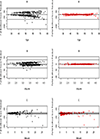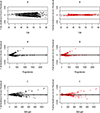Score and deviance residuals based on the full likelihood approach in survival analysis
- PMID: 32776412
- PMCID: PMC7774642
- DOI: 10.1002/pst.2047
Score and deviance residuals based on the full likelihood approach in survival analysis
Abstract
Assuming the proportional hazards model and non-informative censoring, the full likelihood approach is used to obtain two new residuals. The first residual is based on the ideas used in obtaining score-type residuals similar to the partial likelihood approach. The second type of residual is based on the concept of deviance residuals. Extensive simulations are conducted to compare the performance of the residuals from the full likelihood-based approach with those of the partial likelihood method. We demonstrate through simulation studies that the full likelihood-based residuals are more efficient than their partial likelihood counterpart in identifying potential outliers when the censoring proportion is high. The graphical techniques are used to illustrate the applications of these residuals using some examples.
Keywords: deviance residuals; full likelihood; non-informative censoring; partial likelihood; proportional hazards; score-type residuals.
© 2020 John Wiley & Sons Ltd.
Figures





Similar articles
-
Impact of censoring on learning Bayesian networks in survival modelling.Artif Intell Med. 2009 Nov;47(3):199-217. doi: 10.1016/j.artmed.2009.08.001. Epub 2009 Oct 14. Artif Intell Med. 2009. PMID: 19833488
-
Tests for the proportional intensity assumption based on the score process.Lifetime Data Anal. 2004 Jun;10(2):139-57. doi: 10.1023/b:lida.0000030200.61020.85. Lifetime Data Anal. 2004. PMID: 15293629
-
Analysis of time-to-event data using a flexible mixture model under a constraint of proportional hazards.J Biopharm Stat. 2020 Sep 2;30(5):783-796. doi: 10.1080/10543406.2020.1783283. Epub 2020 Jun 26. J Biopharm Stat. 2020. PMID: 32589509
-
Additive hazards model with auxiliary subgroup survival information.Lifetime Data Anal. 2019 Jan;25(1):128-149. doi: 10.1007/s10985-018-9426-7. Epub 2018 Feb 22. Lifetime Data Anal. 2019. PMID: 29470696 Review.
-
Censoring issues in survival analysis.Annu Rev Public Health. 1997;18:83-104. doi: 10.1146/annurev.publhealth.18.1.83. Annu Rev Public Health. 1997. PMID: 9143713 Review.
Cited by
-
Outcomes and Disease Management in Patients With Atrial Fibrillation ≥80 Years: Data From a Consecutive 11-Year Real-World Registry.J Am Heart Assoc. 2025 Feb 18;14(4):e036832. doi: 10.1161/JAHA.124.036832. Epub 2025 Feb 8. J Am Heart Assoc. 2025. PMID: 39921512 Free PMC article.
-
Penalized weighted proportional hazards model for robust variable selection and outlier detection.Stat Med. 2022 Jul 30;41(17):3398-3420. doi: 10.1002/sim.9424. Epub 2022 May 17. Stat Med. 2022. PMID: 35581736 Free PMC article.
References
-
- Cox DR. Regression models and life tables (with discussion). J Roy Stat Soc Series B 1972;74:187–220.
-
- Schoenfeld D Partial residuals for the proportional hazards regression model. Biometrika 1982;69:239–241.
-
- Fleming TR, Harrington DP. Counting Processes and Survival Analysis. Wiley, New York, 1991.
-
- Therneau TM, Grambsch PM. Modeling Survival Data: Extending the Cox Model. Springer, New York, 2000.
-
- Barlow WE, Prentice RL. Residuals for relative risk regression. Biometrika 1988;75:65–74.
Publication types
MeSH terms
Grants and funding
LinkOut - more resources
Full Text Sources

